What You Missed at MozCon 2019 | Day 2
Day 2 of MozCon 2019 was packed with great insights and powerhouse presentations from industry leaders. As the Boostability marketing SEO specialist, I was able to attend and glean some highlights from each of the presenters. Here’s a quick rundown of my notes.
Building a Discoverability Powerhouse: Lessons From Merging an Organic, Paid, & Content Practice | Heather Physioc
To see Heather’s presentation, click here.
In order to have a cohesive marketing team, you need to include every aspect of digital marketing. On most modern marketing teams, there are organic, paid, and content departments. But often you can run into issues with silo-ing and interdepartmental shortsightedness. Heather brings us examples and knowledge of how all these departments can work together for the betterment of your brand and products.
"Interdisciplinarity – Helps to solve for problems like chronic silo'ing"@HeatherPhysioc #MozCon #BoostatMozCon pic.twitter.com/PAwQzsWqNf
— Boostability (@Boostability) July 16, 2019
When integration and collaboration are commonplace, you see wins throughout the whole company. Breaking traditional boundaries can help you see how you can be better. Doing so is not always the easiest.
The larger the team, the harder it is to collaborate – esp. when they do different jobs. Getting too big limits our ability to move quickly. Don’t force homogeneity. Teams can keep their identity & autonomy. Empower them to make decisions that are right for their team. #MozCon pic.twitter.com/qK11Yc6Fmr
— Heather Physioc (@HeatherPhysioc) July 16, 2019
You have to shift away from star athletes on different teams to an all-star team that collaborates and works together toward a common goal. As you are merging these processes, there can be resistance and people might be slow to adopt. You’ll run into conflicting opinions. You may even run into change fatigue, as even your superstars can get burned out and sick of change. But if you are able to make change a relief rather than a burden to your team, then burnout will be less likely to happen.
"Cross-pollinating" skills between teams. Building a networked team throughout your company to help solve problems for sales, paid or organic search…@HeatherPhysioc #MozCon #BoostatMozCon
— Boostability (@Boostability) July 16, 2019
“Building the world’s most connected brands starts with connected teams…The most successful people in the face of change are not the ones who obstruct the inevitable, but the ones who roll up their sleeves and help.” – Heather Physioc
Brand Is King: How to Rule in the New Era of Local Search | Mary Bowling
To see Mary’s presentation, click here.
Mary is known as the local search expert and she helps illustrate why focusing on your brand can help your business get more conversions. She poses the question, “Is Google hijacking your brand’s traffic with zero-click search results?”
By fine tuning our Google SERPs with accurate, appealing, and complete information, we can bring searchers to our site and answer their questions. Using Google My Business and all the available tools is the first change you need to make if you aren’t already doing that.
- Relevance | Does the business provide the products, services or attributes the searcher is asking for?
- Prominence | Is the business well-known and well-regarded within its local market area and its industry?
- Proximity | Is the business close enough to the searcher to be considered a good answer for their search query?
How close is close enough for a ‘local’ search? It depends.
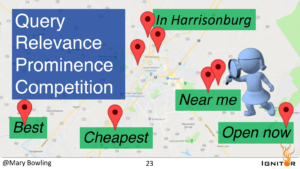
With increased focus on reviews and mobile-friendly presentations layers being added to local search results, you can see the Google is doubling down on local search just in the past four years. Optimizing your brand is how you get ranked locally. Controlling this story should be paramount for your business. Answer the questions your searchers have and what they think is important to know.
“For websites to get the highest possible rating, Google is looking at reputation as well.” – Quality Rater Guidelines
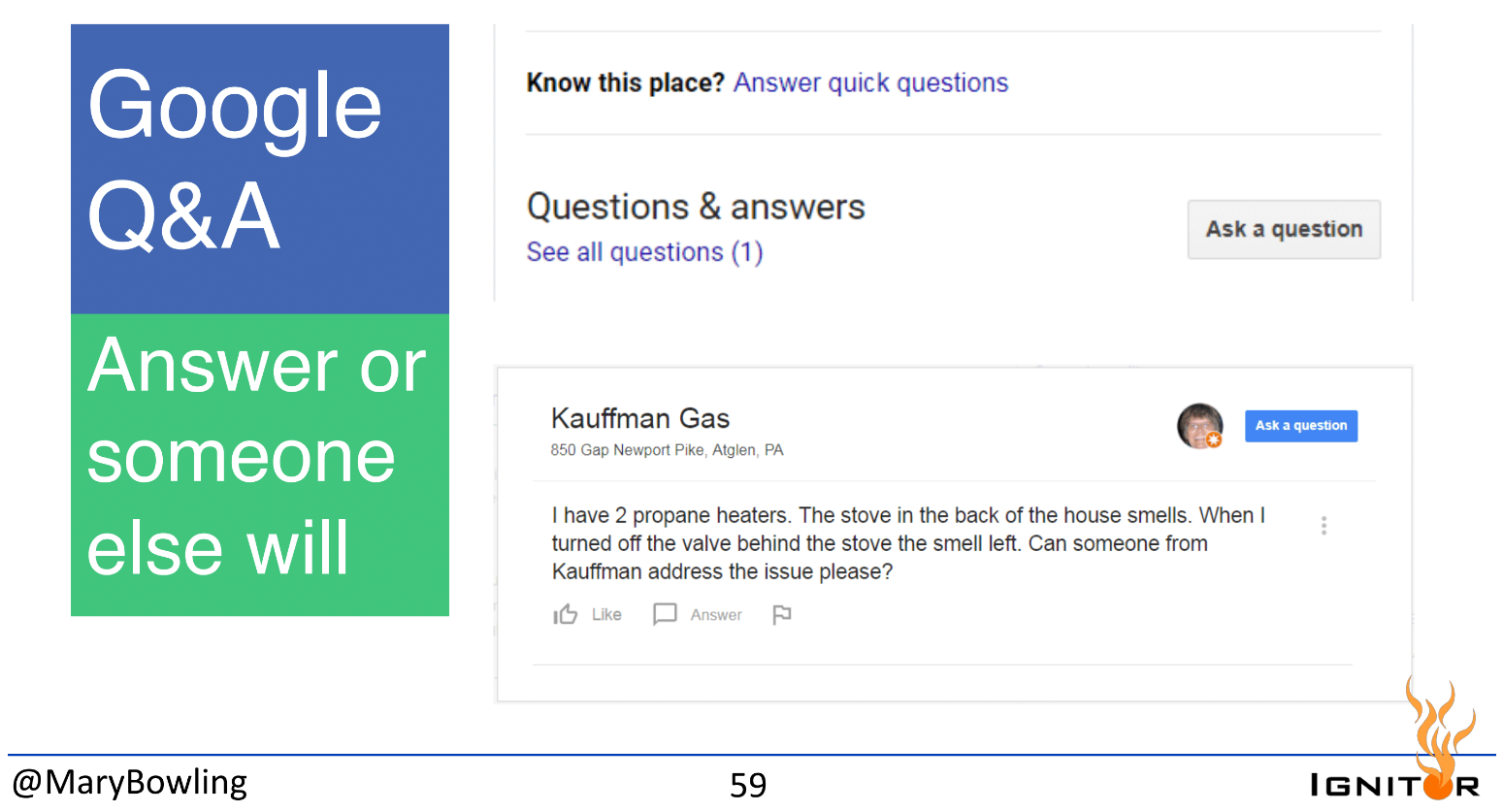
Anyone can answer the questions that are asked from Google’s SERPs. You are the brand authority, so the answers should come from you.
Making Memories: Creating Content People Remember | Casie Gillette
To see Casie’s presentation, click here. To see a great Screaming Frog Guide, click here.
"Use your content to connect with your audience and leverage your brand."@Casieg #MozCon #BoostatMozCon pic.twitter.com/QFl3r4NFB3
— Boostability (@Boostability) July 16, 2019
Creating a story that people actually remember can be extremely difficult without the right tools and direction. Casie helps us sort out what brands are currently doing to capture attention and how everyone—regardless of budget or resources—can create the kind of content their audience will actually remember.
The web is inundated with millions of blog posts a day and many are still not talking to customers about what matters. In order to do this you need to do some research and consider the following:
- Identify Needs
- Think Simple
- Get Creative
- Tell a Story
“Messages delivered as stories can be up to 22x more memorable than just facts.” – Jerome Bruner
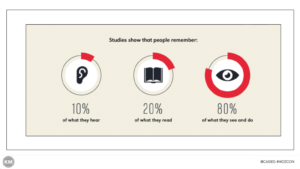
Creative doesn’t have to be hard. If you really want to make something that your audience remembers, you are going to have to think beyond words. When posting or creating a story remember these three things:
- Choose Colors Wisely
- Add Movement
- Location, Location, Location
There’s a reason why the first thing we often ask someone when we meet them, right after learning their name, is ‘where’s home for you?’ If you are a local business then use local images. Location generates connection with your audience.
20 Years in Search & I Don’t Trust My Gut or Google | Wil Reynolds
To see Wil’s presentation, click here.
Wil is a data geek who has 20 years of experience but has found success by always being in hypothesis mode. Adopting bigger data sets helped him expose how some common “best practices” might be giving Google money with no actual return to your business. He states that building systems that look at every single search term you get matched to is the future of search marketing.
Your data is too small. Consider targeting zero volume search terms for higher conversion rate. Don't be narrow minded when considering search terms. YOU COULD BE MISSING OUT ON CONVERSIONS!@wilreynolds #MozCon #BoostatMozCon
— Boostability (@Boostability) July 16, 2019
In his speech he gives us four problems with the current state of keyword research. They are:
- Your Data is Too Small
Targeting zero-volume search keywords can help conversions if you are basing it off the data. Small data is dangerous to your company’s wallet.
- Your Data is Too Silo-ed
Being in hypothesis mode can make you a better marketer. Ask questions and look at the data to get real answers.
- You Have Bias
Just because one campaign worked with one client doesn’t mean it will translate. That kind of anecdotal thinking with end up costing you in the long run.
- Your Data is Slow
Changes happen all the time in data and it can quickly become outdated if you aren’t watching it closely. Don’t make important decisions off slow data.
If you trust Google to lead your PPC campaign, you will be leaving money on the table. Businesses are only in it to help themselves and Google is no exception. He pointed out an instance where Google was essentially having the customer pay for useless clicks while not giving them the opportunity to put more than 20 negative keywords in their campaign.
“Google has built a $17.4 billion business on questionable clicks.” – Wil Reynolds
Super-Practical Tips for Improving Your Site’s E-A-T | Dr. Marie Haynes
To see Dr. Haynes presentation, click here.
"If something is in Google's Quality Raters Guidelines then they are already looking at it algorithmically."
Super-Practical Tips for Improving Your Site's E-A-T@Marie_Haynes #MozCon #BoostatMozCon pic.twitter.com/U8ZeuitQOH
— Boostability (@Boostability) July 16, 2019
Expertise, Authoritativeness, and Trustworthiness, or E-A-T, is part of Google’s algorithm. They have included it in their Quality Rating Guidelines and so we know they are tracking it.
“You can view the rater guidelines as where we want the search algorithm to go… They don’t tell you how the algorithm is ranking results, but they fundamentally show what the algorithm should do.” – Ben Gomes, VP Search at Google
What does all this mean and how can we improve our own authority?
“What I would recommend doing is setting up normal author profiles on the website and using things like the schema.org markup that you can use for articles to tell us about who the authors of your pieces of content are.” – John Mueller, Google Help Hangout
I asked Gary about E-A-T. He said it's largely based on links and mentions on authoritative sites. i.e. if the Washington post mentions you, that's good.
He recommended reading the sections in the QRG on E-A-T as it outlines things well.@methode #Pubcon
— Marie Haynes (@Marie_Haynes) February 21, 2018
When creating a blog post you need to answer the question, “Why is this person qualified to speak on this subject?” If you successfully do that every time, then you are ahead of the game.
Ask your customer service reps what questions they get consistently. Your customers are asking these questions because there isn't an answer online.
This is a great way to help create content that answers questions.@Marie_Haynes #MozCon #BoostatMozCon
— Boostability (@Boostability) July 16, 2019
Answering these questions and being an authority in the marketplace can help overall SEO and backlinks could come rolling in you do so well enough. Sharing your voice and expertise is essential to the future of your digital marketing exploits.
Fixing the Indexability Challenge: A Data-Based Framework | Areej AbuAli
To see Areej’s presentation, click here.
“Technical problems are people problems.”
Crawling, Indexing and Ranking can be helped with a customized framework when directing robots in initial crawls. Areej used search volume as a metric to solve her problem.
Fixing the Indexability Challenge: A Data-Based Framework@areej_abuali #MozCon #BoostatMozCon pic.twitter.com/N6EU7JyGBt
— Boostability (@Boostability) July 16, 2019
Sometimes using a framework to direct the Google bots to crawl your site in a specific way is necessary. If your indexability is not in check, then crawls will visit your site less and less until you fix it. This includes optimization for H1, title tags, meta descriptions, sitemaps, and canonical tags.
If your SEO recommendation are solid make sure they are implemented correctly. As a tech SEO, the most you can do is influence priorities. Getting the basics right is so fundamental. If you can do nothing else, just do the tech.
What Voice Means for Search Marketers: Top Findings from the 2019 Report | Christi Olson
To see Christi’s presentation, click here. To read the Microsoft Whitepaper Voice Report, click here.
Voice search is on the rise and is different from normal SERPs but it is pulling data that we are already optimizing for. It is moving from answer to actions. Talking about things like, “I want to go”, “I want to do,” and “ I want to know.”
Christi's son Roy can't type – but he can talk! That means he can search. @ChristiJOlson #MozCon
— Ruth Burr Reedy (@ruthburr) July 16, 2019
Speaking to a machine can be done by a wider variety of people and is becoming more and more accessible. The conversational methodology of search is becoming commonplace. Those companies that optimize for this early will be on the forefront of technology.
"40% of all spoken responses come from a featured snippet."
Optimizing for voice=Optimizing for featured snippets.@ChristiJOlson #MozCon #BoostatMozCon
— Boostability (@Boostability) July 16, 2019
How to optimize for voice/snippets:
- Find queries where you are currently ranking in the top 10
- Identify questions related to that query
- Choose how to structure your answer (paragraph, table list)
- Provide a straightforward answer that adds value
- Write the answers so it sounds natural when spoken aloud.
- Think about character count – does it fit on a mobile screen?
- Make it easy to find—SEO best practices + Fast Loading Pages + Schema
Redefining Technical SEO | Paul Shapiro
To see Paul’s presentation, click here. To see his Python scripts, click here.
When we think of SEO we often compartmentalize it into different sections or “pillars” according to Paul:
- Content Strategy
- Digital PR & Link Building
- Technical SEO
What he illustrates afterward is how all parts are woven together and can be, in essence, technical SEO.
"Link building can be a technical SEO task. Using expired domains and running a Python script to determine which links to pursue. Technical."@fighto #MozCon #BoostatMozCon
— Boostability (@Boostability) July 16, 2019
Technical SEO can be defined as any sufficiently technical action undertaken with the intent to improve search results.
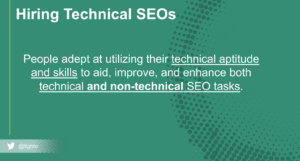
Having the ability to problem solve and think critically can help every aspect of the SEO process. Communicating those thoughts and explain complex, technical topics are also essential to finding someone who can help with technical SEO on your marketing team.
How Many Words Is a Question Worth? | Dr. Pete Meyers
To see Dr. Meyer’s presentation, click here.
There are so many different ways to rank and create content. One of the ways is to pose a question and answer post. Dr. Pete walks us through some great tools we can use to help guide our decisions for which questions we as and how we answer them effectively.
Looking at Google’s SERPs there are instances that People Also Ask (PAAs) are using questions to continue a dialog with the searcher. We have recently seen an exponential increase in these types of snippets.
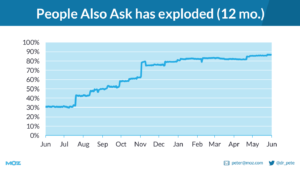
Targeting these types of results can be beneficial and here are a few ways you can do this:
- Credibility | Make sure you are credible enough to answer the question.
- Competition | Has the question already been answered? Should they be answering the question?
- Cannibalization | Are you competing with yourself?
If you want to rank for a question that you are asking then it is best to remember the inverted pyramid for answers to the question.
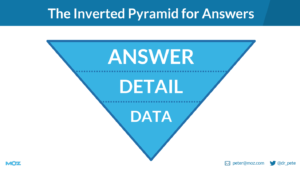
Answer the question in the first two sentences of the piece. Provide details on how that affects the question asker. Backup anything with the data set you used to answer the question. Following this will help you rank for a wide variety of searches.
Are you asking the right questions?
Using search volume and ranking keywords you can gain insights on what questions to ask and how to answer them for the benefit of everyone involved.

